2018 MERCEDES-BENZ CLA flat tire
[x] Cancel search: flat tirePage 284 of 326
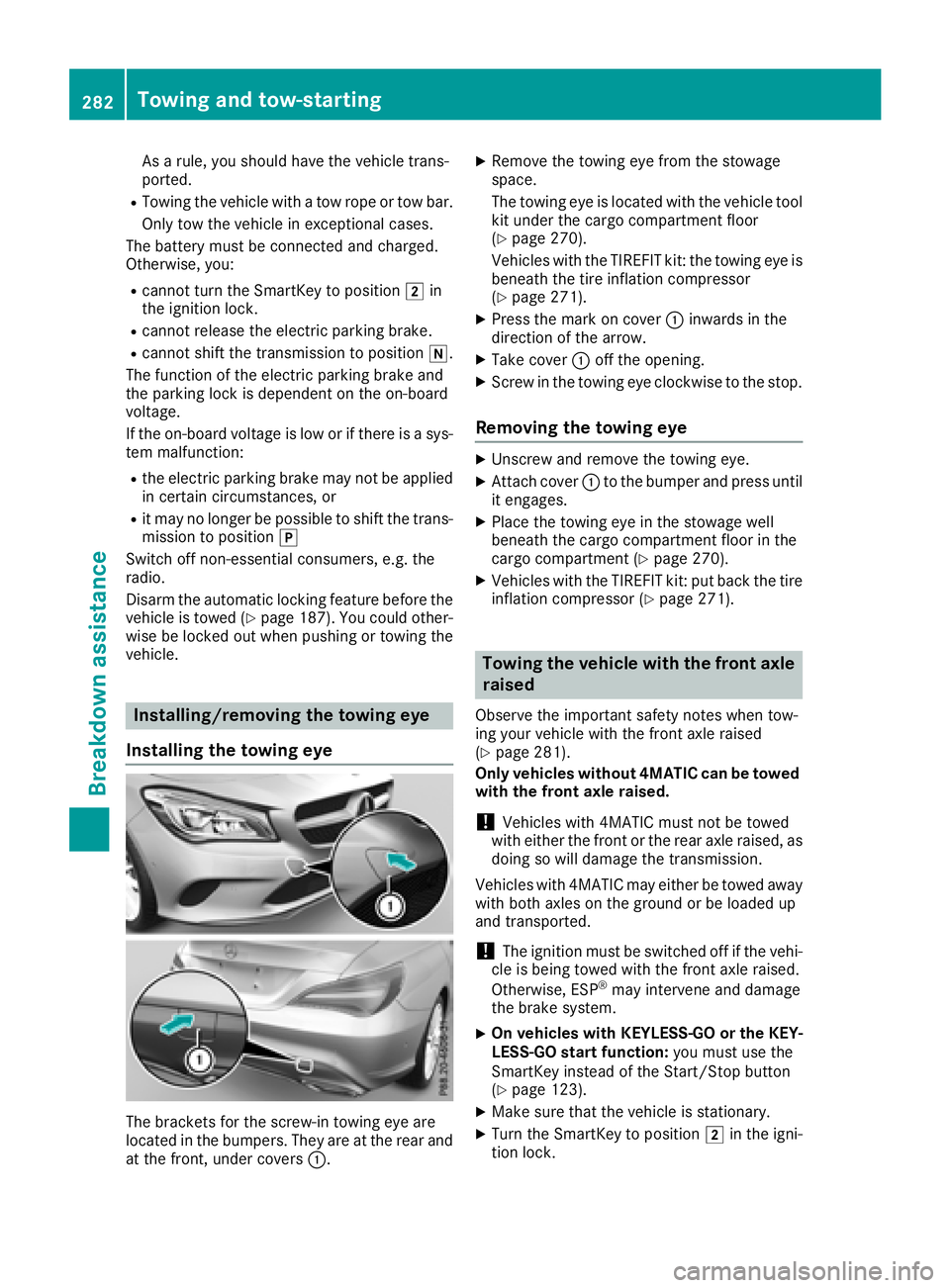
As ar ule, yo us houl dh av et he vehicl et rans-
ported. R
Towing the vehicl ew it hat ow rop eort ow bar.
Onl yt ow the vehicl eine xceptiona lc ases.
The battery must be connected and charged.
Otherwise, you: R
canno tt urn the SmartKe ytop osition �H in
the ignition lock. R
canno tr elease the electri cp ar king brake.R
canno ts hift the transmission to position �\\ .
The functio noft he electri cp ar king brake and
the parking lock is dependent on the on-board
voltage.
If the on-board voltag eisl ow or if ther eisas ys -
tem malfunction: R
the electri cp ar king brake ma yn ot be applied
in certain circumstances ,o rR
it ma ynol on ge rbep os sibl etos hift the trans-
mission to position �]
Switch off non-essentia lc onsumers, e.g .t he
radio.
Disar mt he automatic locking feature before the
vehicl eist owed ( Y
page 187). Yo uc ould other-
wise be locked ou tw he np us hing or towing the
vehicle.
Installing/removin gt he towin ge ye
Installing the towin ge ye
The brackets for the screw-i nt owing ey ea re
locate dint he bumpers. The ya re at the rea ra nd
at the front, under covers �C . X
Remove the towing ey ef rom the stowage
space.
The towing ey eisl oc ate dw it ht he vehicl et ool
kit under the cargo compartment floor
( Y
page 270).
Vehicles with the TIREFIT kit: the towing ey ei s
beneath the tire inflation compressor
( Y
page 271). X
Press the mark on cover �C inwards in the
direction of the arrow. X
Take cover �C off the opening. X
Screw in the towing ey ec lockwise to the stop.
Removing the towin ge ye X
Unscrew and remove the towing eye. X
Attach cover �C to the bumpe ra nd press until
it engages. X
Place the towing ey eint he stowag ew el l
beneath the cargo compartment floor in the
cargo compartment ( Y
page 270).X
Vehicles with the TIREFIT kit: pu tb ac kt he tire
inflation compressor ( Y
page 271).
Towin gt he vehicle with the fron ta xle
raised Observ et he important safety notes when tow-
ing your vehicl ew it ht he front axl er aised
( Y
page 281).
Only vehicle sw it hou t4 MATIC can be towed
with the fron ta xl er aised.
! Vehicles with 4MATIC must not be towed
with either the front or the rea ra xl er aised, as
doing so will damage the transmission.
Vehicles with 4MATIC ma ye it her be towed away
with both axles on the ground or be loaded up
and transported.
! The ignition must be switched off if the vehi-
cle is being towed with the front axl er aised.
Otherwise, ESP ®
ma yi ntervene and damage
the brake system. X
On vehicle sw it hK EYLESS -GO or the KEY-
LESS-GO start function: yo um us tu se the
SmartKe yi nstea doft he Start/Stop button
( Y
page 123). X
Make sure tha tt he vehicl eiss tationary.X
Turn the SmartKe ytop osit ion �H in the igni-
tio nl oc k.282
Towin ga nd tow-starting
Breakdo wn assis tance
Page 289 of 326
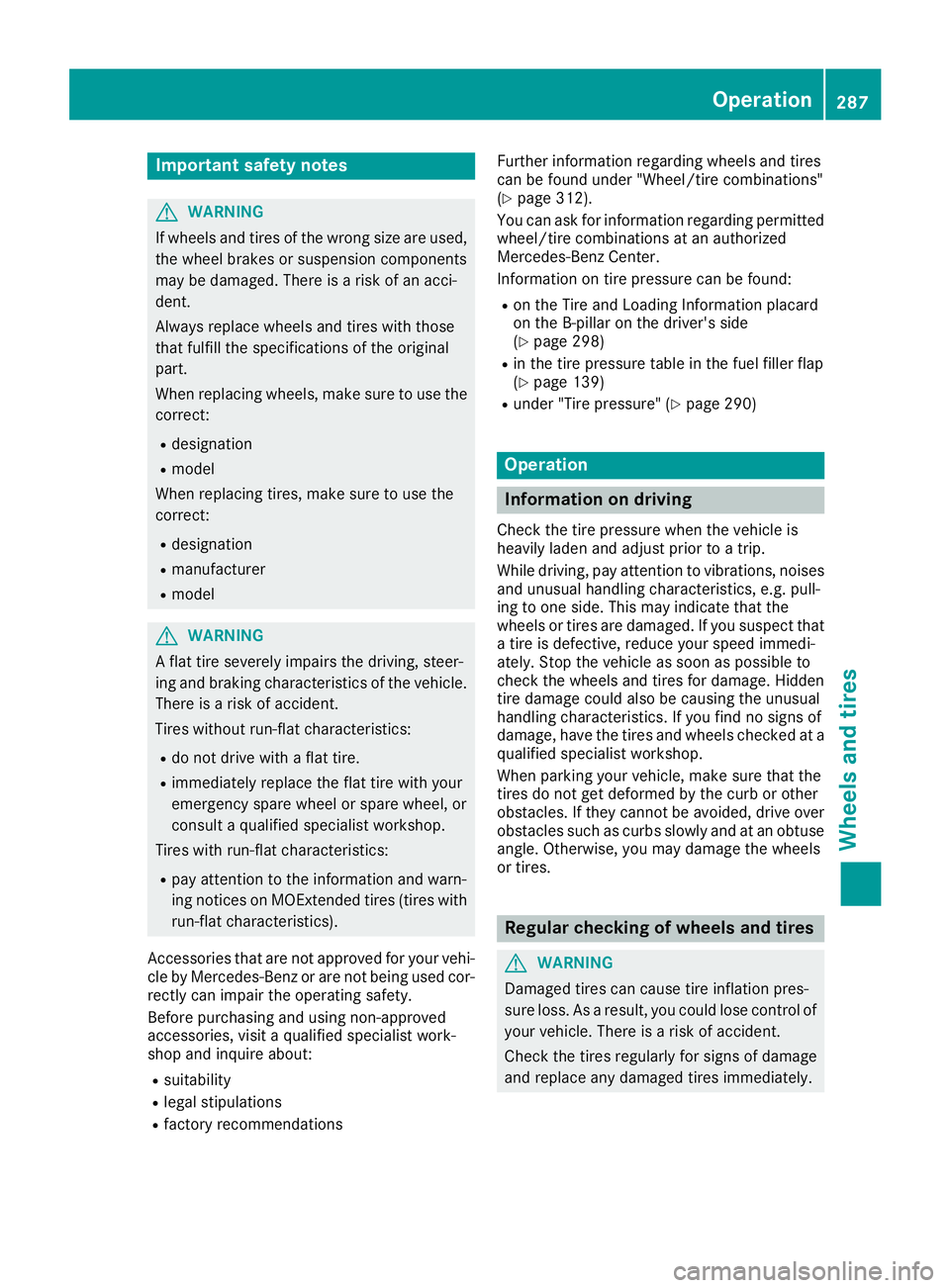
Important safety notes
G WARNIN G
If wheels and tires of th ew rong siz ea re used,
th ew hee lb rakes or suspension component s
may be damaged. Ther eisar is kofana cci-
dent.
Always replace wheels and tires wit ht ho se
that fulfill th es pecification soft he original
part .
When replacing wheels, mak es ur etou se th e
correct: R
designation R
model
When replacing tires ,m ak es ur etou se th e
correct: R
designation R
manufacturer R
model
G WARNIN G
Af lat tire severely impairs th ed riving ,s te er -
ing and braking characteristics of th ev ehicle.
Ther eisar is kofa ccident.
Tires without run-flat characteristics :R
do no td riv ew it haf lat tire.R
immediately replace th ef lat tire wit hy our
emergenc ys par ew hee lors par ew heel, or
consult aq ualified specialist workshop.
Tires wit hr un-flat characteristics :R
pay attention to th ei nformation and warn -
ing notice sonM OExtended tires (tire sw it h
run-flat characteristics).
Accessories that are no ta pprove df or your vehi-
cle by Mercedes-Ben zora re no tb ein gu sed cor-
rectl yc an impair th eo perating safety.
Before purchasing and usin gn on-ap prove d
accessories, visit aq ualified specialist work-
sho pa nd inquire about :R
suitabilit yR
legal stipulation sR
factory recommendation s Further information regarding wheels and tires
can be foun du nder "Wheel/tire combinations"
( Y
page 312).
You can ask for information regarding permitte d
wheel/tire combination satana uthorize d
Mercedes-Ben zC enter.
Information on tire pressur ec an be found:R
on th eT ir ea nd Loading Information placard
on th eB -p illar on th ed river' ss ide
( Y
page 298) R
in th et ir ep ressur et able in th ef uel filler flap
( Y
page 139) R
under "Tir ep ressure" ( Y
page 290)
Operation
Information on driving Chec kt he tire pressur ew hen th ev ehicl ei s
heavily laden and adjust prio rtoat ri p.
While driving ,p ay attention to vibrations, noises
and unusual handlin gc ha racteristics ,e .g .p ull-
ing to on es ide .T his may indicat et ha tt he
wheels or tires are damaged. If you suspec tt ha t
at ir eisd efective, reduce your spee di mmedi-
ately. Stop th ev ehicl eass oo nasp ossible to
chec kt he wheels and tires for damage. Hidden
tire damag ec ou ld also be causing th eu nusual
handlin gc ha racteristics .Ify ou fin dnos ign so f
damage, hav et he tires and wheels checke data
qualified specialist workshop.
When parking your vehicle, mak es ur et ha tt he
tires do no tg et deformed by th ec ur boro th er
obstacles. If they canno tbea voided, driv eo ve r
obstacles suc hasc urbs slowly and at an obtuse
angle. Otherwise, you may damag et he wheels
or tires .
Regula rc hecking of wheels and tires
G WARNIN G
Damaged tires can caus et ir ei nflation pres-
sur el oss .Asar esult ,y ou could lose control of
your vehicle. Ther eisar is kofa ccident.
Chec kt he tires regularly for sign sofd amag e
and replace any damaged tires immediately. Operation 287
Wheels and tires Z
Page 291 of 326
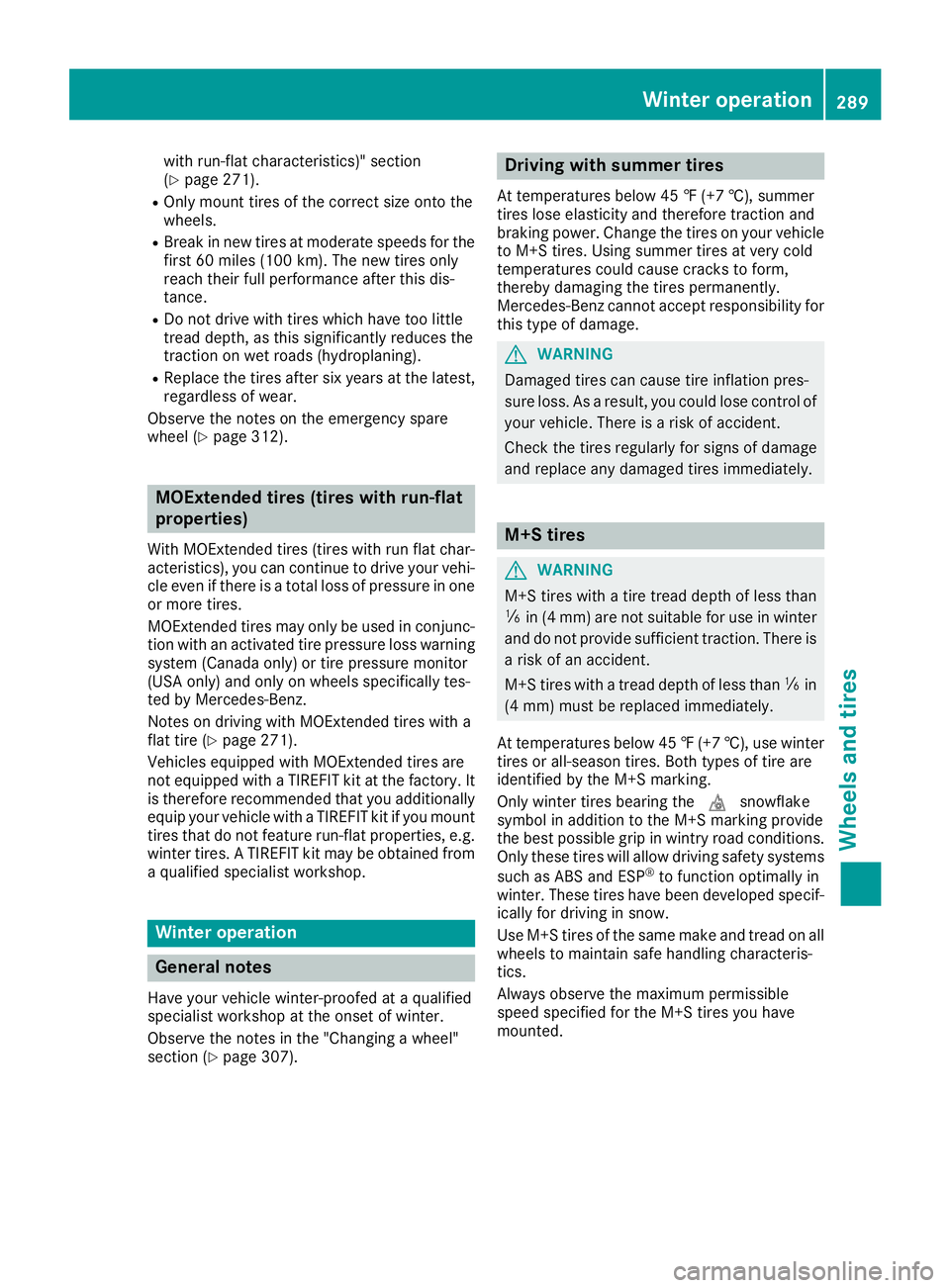
with run-flat characteristics) "s ection
( Y
page 271). R
Only moun tt ires of th ec orrec ts iz eo nt ot he
wheels. R
Break in new tires at moderat es peeds for the
firs t6 0m iles (10 0k m) .T he ne wt ires only
reac ht he ir full performanc ea fter this dis-
tance. R
Do not driv ew ith tires which have too little
tread depth, as this significantly reduces the
traction on wet roads (hydroplaning). R
Replace th et ires after six years at th el atest,
regardless of wear.
Observe th en otes on th ee mergency spare
wheel ( Y
page 312).
MOExtended tires (tires with run-flat
properties) With MOExtended tires (tires with run flat char-
acteristics) ,y ou can continue to driv ey our vehi-
cle even if there is at otal loss of pressure in one
or mor et ires.
MOExtended tires may only be used in conjunc-
tio nw ith an activated tir ep ressure loss warning
system (Canada only) or tir ep ressure monitor
(US Ao nly) and only on wheels specifically tes-
ted by Mercedes-Benz.
Notes on driving with MOExtended tires with a
flat tir e( Y
page 271).
Vehicles equipped with MOExtended tires are
not equipped with aT IREFIT kit at th ef actory. It
is therefore recommended that you additionally
equip your vehicle with aT IREFIT kit if you mount
tires that do not feature run-flat properties, e.g.
winter tires. AT IREFI Tk it may be obtained from
aq ualified specialist workshop.
Winter operation
General notes Have your vehicle winter-proofed at aq ualified
specialist workshop at th eo nset of winter.
Observe th en otes in th e" Changing aw heel"
sectio n( Y
page 307). Driving with summer tires At temperatures below 45 ‡( +7 †) ,s umme r
tire sl os ee las ti cit ya nd therefore traction and
braking power .C hange th et ires on your vehicle
to M+S tires. Usin gs ummer tires at ver yc old
temperatures coul dc aus ec ra ck stof orm,
thereb yd amaging th et ires permanently.
Mercedes-Ben zc anno ta ccept responsibilit yf or
this type of damage.
G WARNING
Damaged tires can caus et ir ei nflation pres-
sure loss .Asar esult, you coul dl ose control of
your vehicle .T her eisar isk of accident.
Chec kt he tires regularly for sign sofd amage
and replace any damage dt ires immediately.
M+S tires
G WARNING
M+S tires with at ir et re ad dept hofl ess than
�
Page 292 of 326
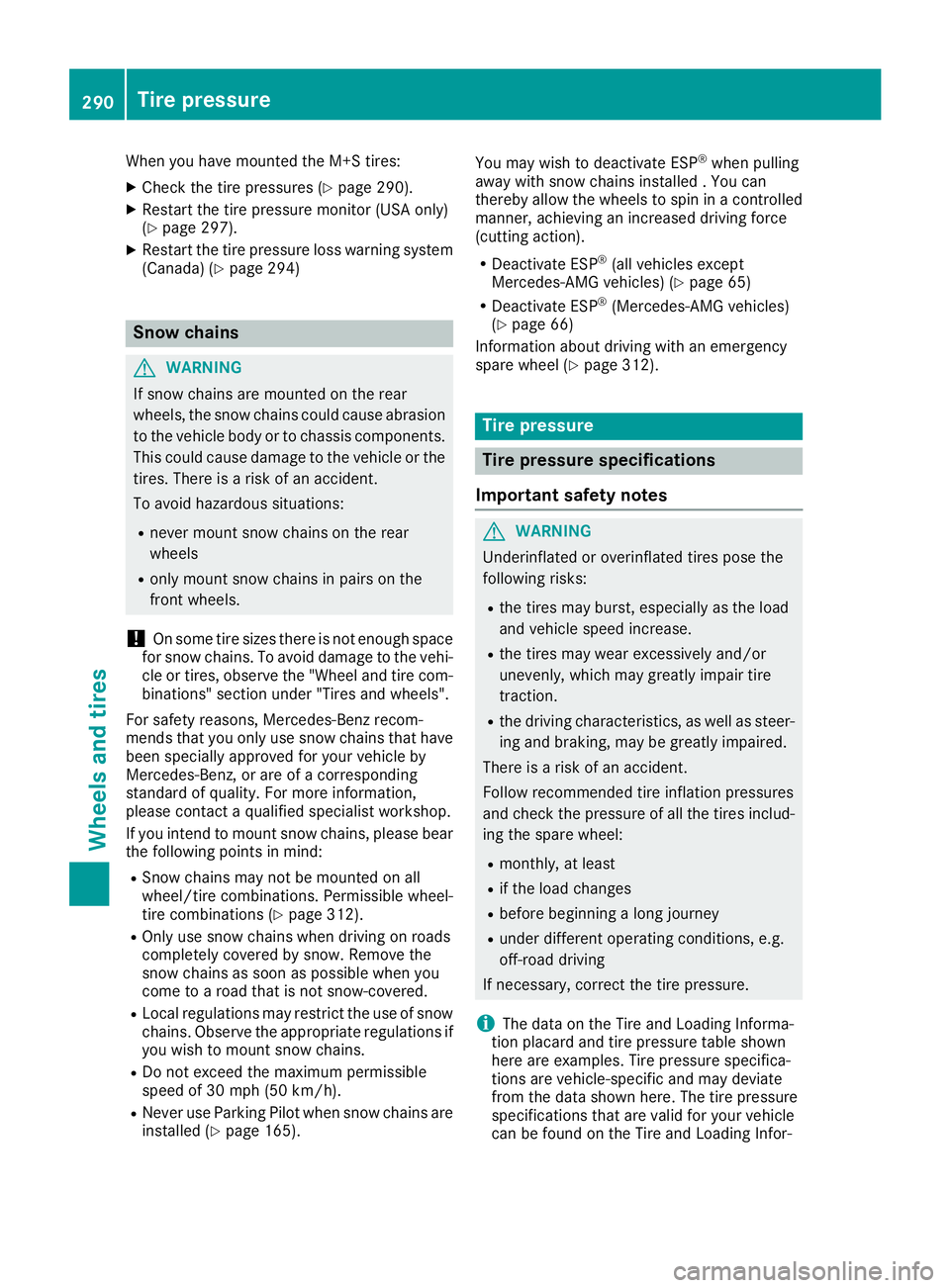
When you have mounted the M+S tires: X
Check the tire pressures ( Y
page 290).X
Restart the tire pressure monitor (USA only)
( Y
page 297).X
Restart the tire pressure loss warning system
(Canada) ( Y
page 294)
Snow chains
G WARNING
If snow chains are mounted on the rear
wheels, the snow chains could cause abrasion
to the vehicle body or to chassis components.
This could cause damage to the vehicle or the
tires. There is ar isk of an accident.
To avoid hazardous situations: R
never mount snow chains on the rear
wheels R
only mount snow chains in pairs on the
fron tw heels.
! On some tire sizes there is not enough space
for snow chains. To avoid damage to the vehi-
cle or tires, observe the "Wheel and tire com-
binations" section under "Tires and wheels".
For safety reasons, Mercedes-Benz recom-
mends that you only use snow chains that have
been specially approved for your vehicle by
Mercedes-Benz ,ora re of ac orresponding
standard of quality. For more information,
please contact aq ualified specialist workshop.
If you inten dtom ount snow chains, please bear
the following points in mind: R
Sno wc hains may not be mounted on all
wheel/tire combinations. Permissible wheel-
tire combinations ( Y
page 312).R
Only use snow chains when driving on roads
completely covered by snow. Remove the
snow chains as soon as possible when you
come to ar oad that is not snow-covered.R
Local regulations may restrict the use of snow
chains. Observe the appropriate regulations if
you wish to mount snow chains. R
Do not exceed the maximum permissible
speed of 30 mph (50 km/h). R
Never use Parking Pilot when snow chains are
installed ( Y
page 165). You may wish to deactivat eE SP ®
when pulling
away with snow chains installed .Y ou can
thereby allow the wheels to spin in ac ontrolled
manner, achieving an increased driving force
(cutting action). R
Deactivate ESP ®
(all vehicles except
Mercedes-AMG vehicles) ( Y
page 65)R
Deactivate ESP ®
(Mercedes-AMG vehicles)
( Y
page 66)
Information about driving with an emergency
spare wheel ( Y
page 312).
Tir ep re ssure
Tir ep re ssure specifications
Important safety notes
G WARNING
Underinflated or overinflated tires pose the
following risks: R
the tires may burst, especially as the load
and vehicle speed increase. R
the tires may wear excessively and/or
unevenly, which may greatly impair tire
traction. R
the driving characteristics, as well as steer-
ing and braking, may be greatly impaired.
There is ar isk of an accident.
Follow recommended tire inflation pressures
and check the pressure of all the tires includ-
ing the spare wheel: R
monthly, at least R
if the load changes R
before beginnin gal ong journeyR
under differen to perating conditions, e.g.
off-road driving
If necessary, correct the tire pressure.
i The data on the Tire and Loading Informa-
tion placard and tire pressure table shown
here are examples. Tire pressure specifica-
tions are vehicle-specific and may deviate
from the data shown here. The tire pressure
specifications that are valid for your vehicle
can be found on the Tire and Loading Infor-290
Tir ep re ssure
Wheels and tires
Page 294 of 326
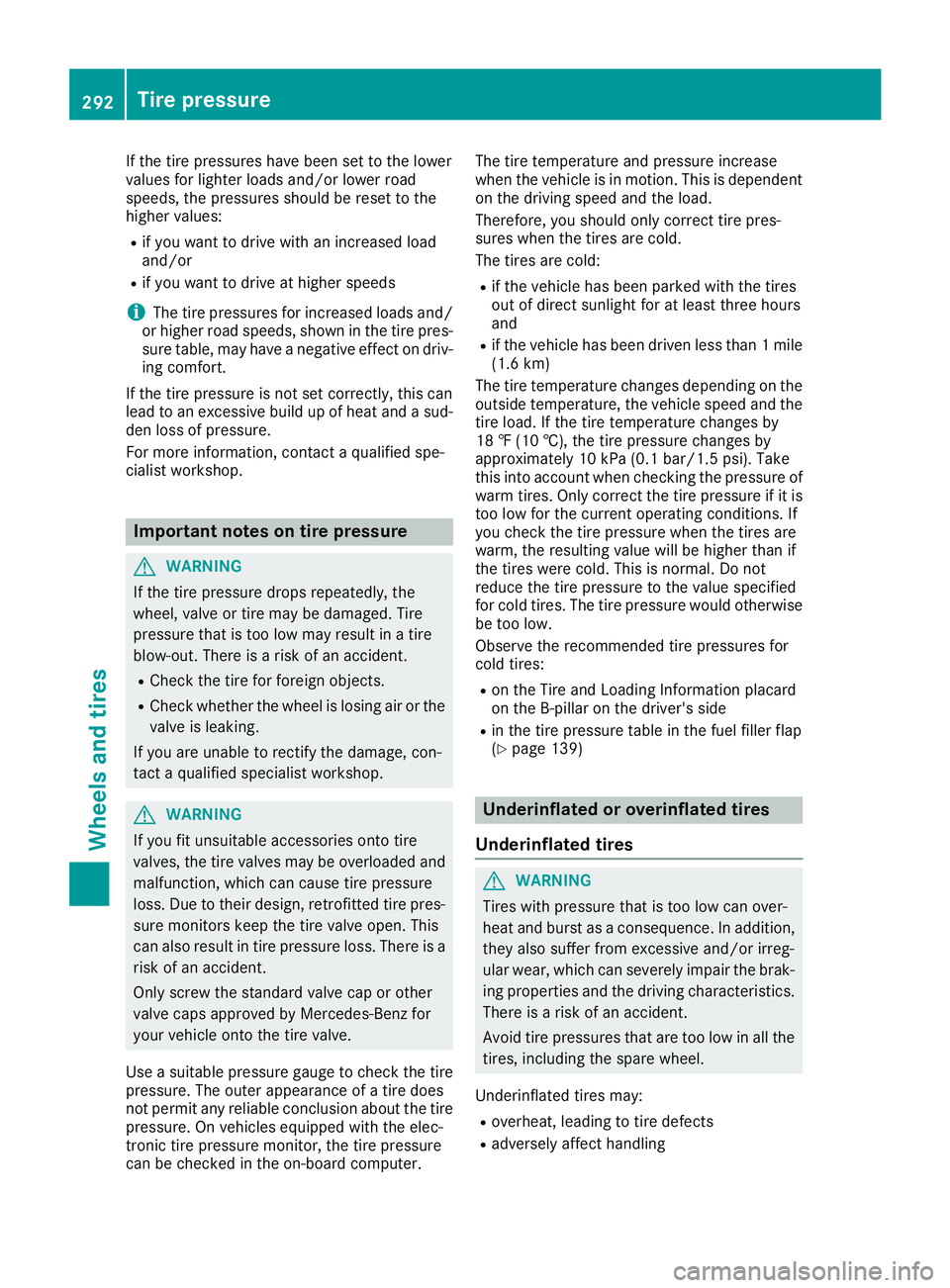
If the tire pressures have been set to the lower
values for lighter load sa nd/or lowe rr oad
speeds, the pressures shoul dber eset to the
higher values: R
if you want to drive with an increased load
and/or R
if you want to drive at higher speeds
i The tire pressures for increased load sa nd/
or higher road speeds, shown in the tire pres-
sure table, may have an egative effect on driv-
ing comfort.
If the tire pressure is not set correctly, this can
lea dtoane xcessive build up of heat and as ud-
den loss of pressure.
For more information, contact aq ualifie ds pe-
cialist workshop.
Important notes on tire pressure
G WARNING
If the tire pressure drops repeatedly ,t he
wheel ,v alve or tire may be damaged. Tire
pressure that is too low may resul tina tire
blow-out. There is ar isk of an accident.R
Check the tire for foreign objects. R
Check whether the wheel is losing air or the
valve is leaking.
If you are unabl etor ectify the damage, con-
tact aq ualifie ds pecialist workshop.
G WARNING
If you fit unsuitable accessorie so nto tire
valves ,t he tire valves may be overloaded and
malfunction, which can cause tire pressure
loss. Due to their design, retrofitted tire pres-
sure monitors keep the tire valve open. This
can also resul tint ire pressure loss. There is a
risk of an accident.
Only screw the standard valve cap or other
valve caps approved by Mercedes-Benz for
you rv ehicle onto the tire valve.
Use as uitable pressure gauge to check the tire
pressure. The outer appearance of at ire does
not permit any reliable conclusion abou tt he tire
pressure. On vehicle se quipped with the elec-
tronic tire pressure monitor, the tire pressure
can be checked in the on-board computer. The tire temperature and pressure increase
when the vehicle is in motion. This is dependent
on the driving speed and the load.
Therefore, you shoul do nly correct tire pres-
sures when the tires are cold.
The tires are cold: R
if the vehicle has been parked with the tires
out of direct sunlight for at least three hours
and R
if the vehicle has been driven less than 1m ile
(1.6 km)
The tire temperature changes depending on the
outsid et emperature ,t he vehicle speed and the
tire load .Ift he tire temperature changes by
18 ‡( 10 †), the tire pressure changes by
approximately 10 kPa (0.1 bar/1.5 psi) .T ake
this into account when checking the pressure of
warm tires. Only correct the tire pressure if it is
too low for the current operating conditions. If
you check the tire pressure when the tires are
warm, the resulting valu ew il lbeh ighe rt han if
the tires were cold. This is normal. Do not
reduce the tire pressure to the valu es pecified
for cold tires. The tire pressure would otherwise
be too low.
Observe the recommended tire pressures for
cold tires: R
on the Tire and Loading Information placard
on the B-pilla ront he driver's sideR
in the tire pressure table in the fuel fille rf lap
( Y
page 139)
Underinflated or overinflated tires
Underinflated tires
G WARNING
Tires with pressure that is too low can over-
heat and burst as ac onsequence. In addition,
they also suffer from excessive and/or irreg-
ula rw ear, which can severel yi mpair the brak-
ing propertie sa nd the driving characteristics.
There is ar isk of an accident.
Avoid tire pressures that are too low in all the
tires, including the spare wheel.
Underinflated tires may: R
overheat, leading to tire defects R
adversely affect handling292
Tire pressure
Wheel sa nd tires
Page 295 of 326
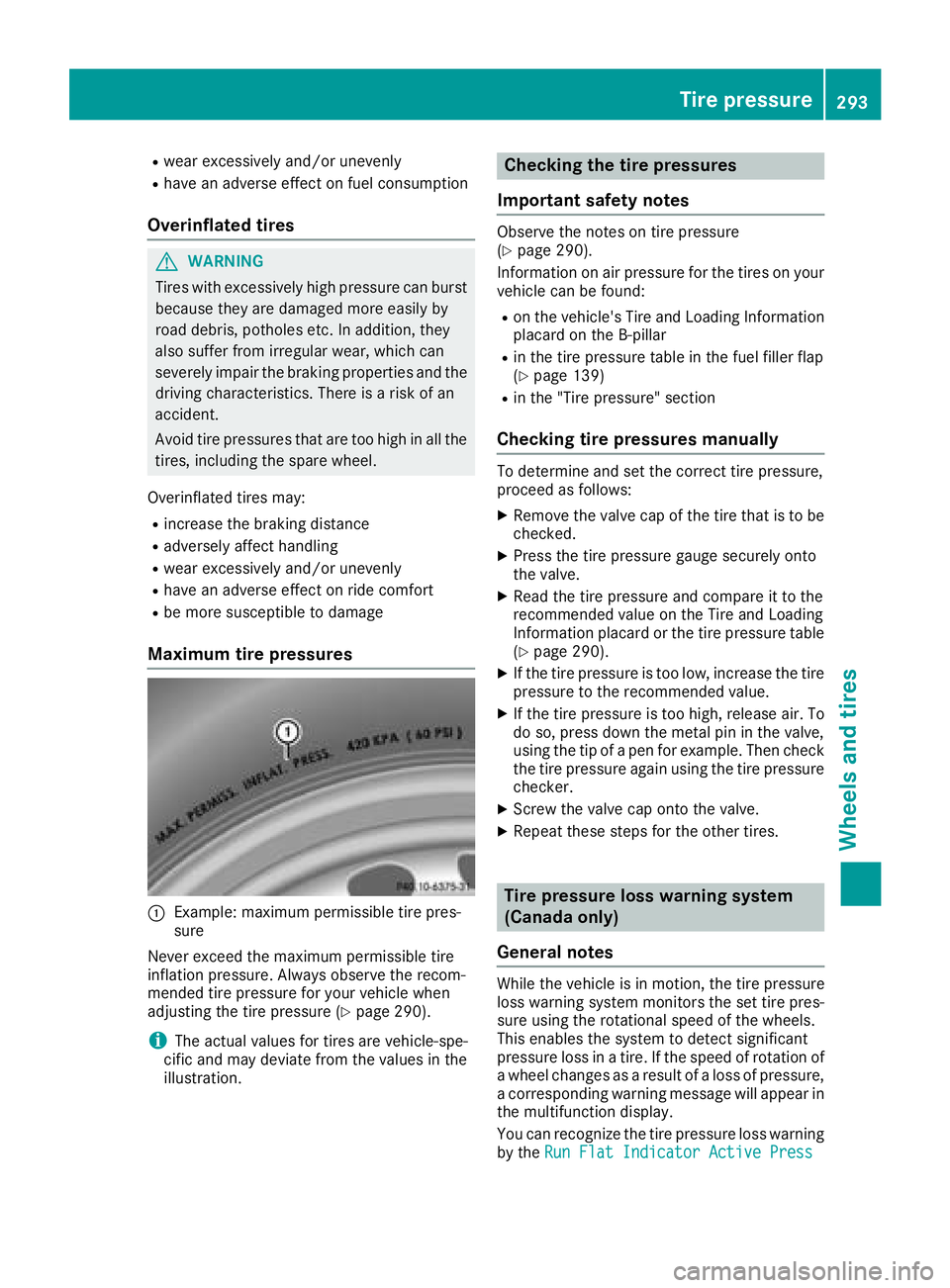
R
wear excessively and/or unevenly R
have an adverse effect on fuel consumption
Overinflated tires
G WARNING
Tires with excessively high pressure can burst
becaus et he ya re damaged mor ee asily by
road debris ,p otholes etc .Ina ddition, they
also suffer fro mi rregular wear, which can
severely impair th eb raking properties and the
driving characteristics. Ther eisar isk of an
accident.
Avoid tir ep ressures that are too high in all the
tires, including th es pare wheel.
Overinflated tires may: R
increase th eb raking distanceR
adversely affect handling R
wear excessively and/or unevenly R
have an adverse effect on ride comfort R
be mor es usceptible to damage
Maximu mt ir ep re ssures
�C
Example: maximum permissible tir ep res-
sure
Never exceed th em aximum permissible tire
inflatio np ressure. Always observe th er ecom-
mended tir ep ressure for your vehicle when
adjustin gt he tir ep ressure ( Y
page 290).
i The actual values for tires are vehicle-spe-
cific and may deviat ef ro mt he values in the
illustration. Checking th et ir ep re ssures
Important safety notes Observe th en otes on tir ep ressure
( Y
page 290).
Information on air pressure for th et ires on your
vehicle can be found: R
on th ev ehicle's Tire and Loadin gI nf ormation
placar dont he B-pillar R
in th et ir ep ressure table in th ef uel filler flap
( Y
page 139) R
in th e" Tire pressure" section
Checking tir ep re ssures manuallyTo determine and set th ec orrec tt ir ep ressure,
proceed as follows: X
Remov et he valve cap of th et ir et ha tistob e
checked. X
Pres st he tir ep ressure gauge securely onto
th ev alve. X
Read th et ir ep ressure and compare it to the
recommended value on th eT ire and Loading
Information placar dort he tir ep ressure table
( Y
page 290). X
If th et ir ep ressure is too low, increase th et ire
pressure to th er ecommended value. X
If th et ir ep ressure is too high, releas ea ir. To
do so, pres sd own th em etal pin in th ev alve,
using th et ip of ap en for example. Then check
th et ir ep ressure again using th et ir ep ressure
checker. X
Screw th ev alve cap ont ot he valve.X
Repeat these steps for th eo ther tires.
Tir ep re ssur el oss warning system
(Canada only)
General notes While th ev ehicle is in motion, th et ir ep ressure
loss warning system monitors th es et tir ep res-
sure using th er otational speed of th ew heels.
This enables th es ystem to detect significant
pressure loss in at ire. If th es peed of rotation of
aw heel changes as ar esult of al oss of pressure,
ac orresponding warning message will appear in
th em ultifunction display.
You can recognize th et ir ep ressure loss warning
by the Run Flat Indicato rA ctive PressTir ep re ssure 293
Wheels and tires Z
Page 296 of 326
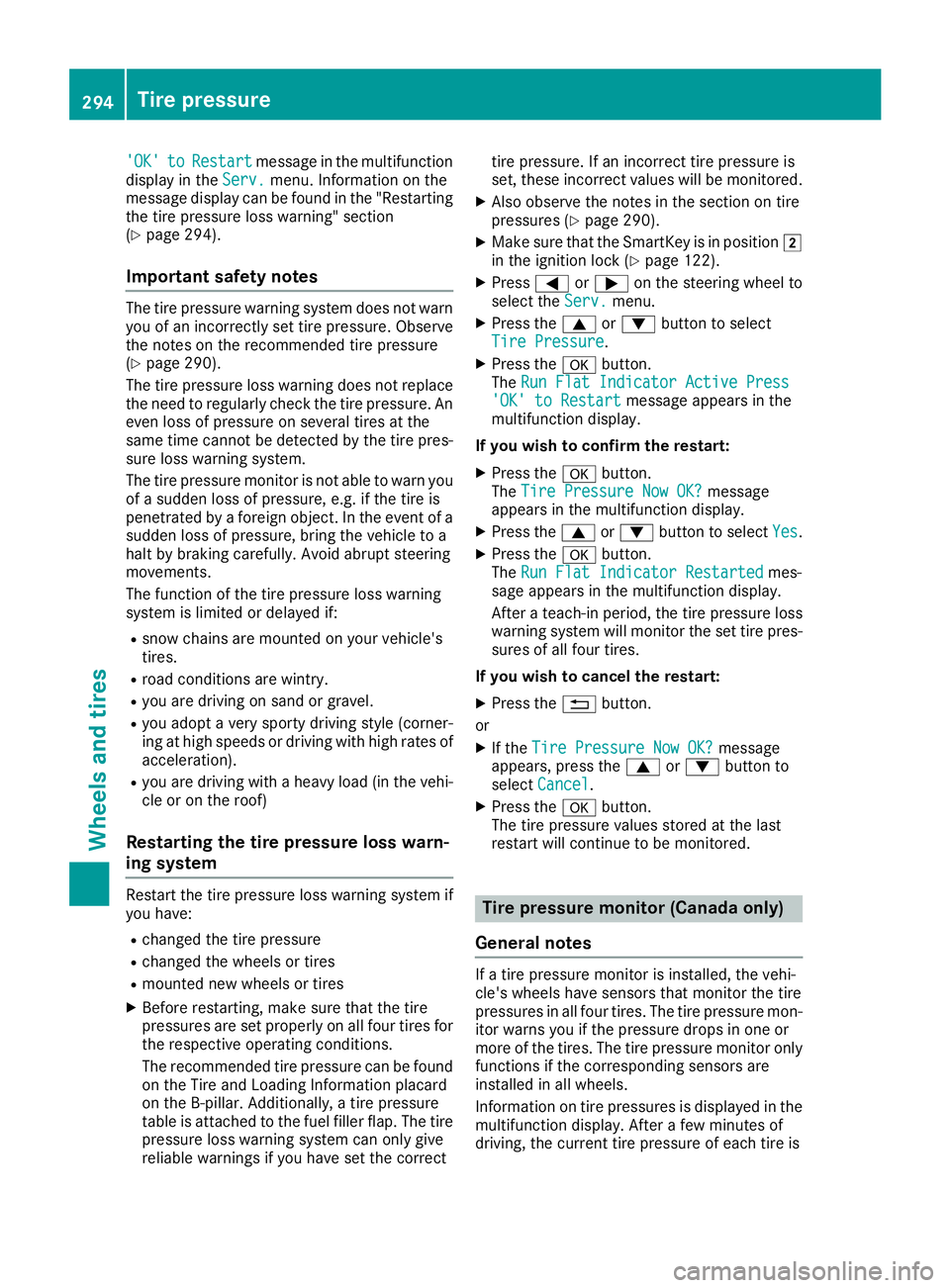
'OK' to Restart message in the multifunction
displa yint he Serv. menu. Information on the
message displa yc an be found in the "Restarting
the tire pressure loss warning" section
( Y
page 294).
Important safety notes The tire pressure warning system does not warn
you of an incorrectly set tire pressure. Observe
the notes on the recommended tire pressure
( Y
page 290).
The tire pressure loss warning does not replace
the need to regularly check the tire pressure. An
even loss of pressure on several tires at the
same time cannot be detected by the tire pres-
sure loss warning system.
The tire pressure monitor is not able to warn you
of as udden loss of pressure, e.g. if the tire is
penetrated by af oreign object. In the event of a
sudden loss of pressure, bring the vehicle to a
halt by braking carefully .A void abrupt steering
movements.
The function of the tire pressure loss warning
system is limited or delayed if: R
snow chains are mounted on your vehicle's
tires. R
road conditions are wintry. R
you are driving on sand or gravel. R
you adopt av ery sporty driving style (corner-
ing at high speeds or driving with high rates of
acceleration). R
you are driving with ah eavy load (in the vehi-
cle or on the roof)
Restarting the tire pressure loss warn-
ing system Restart the tire pressure loss warning system if
you have: R
changed the tire pressure R
changed the wheels or tires R
mounted new wheels or tires X
Before restarting, make sure that the tire
pressures are set properly on all four tires for
the respective operating conditions.
The recommended tire pressure can be found
on the Tire and Loading Information placard
on the B-pillar. Additionally ,at ire pressure
table is attached to the fuel filler flap. The tire
pressure loss warning system can only give
reliable warnings if you have set the correct tire pressure. If an incorrect tire pressure is
set, these incorrect value sw ill be monitored.X
Also observe the notes in the section on tire
pressures ( Y
page 290). X
Make sure that the SmartKey is in position �H
in the ignition lock ( Y
page 122).X
Press �Y or �e on the steering wheel to
select the Serv. menu.X
Press the �c or �d button to select
Tire Pressure . X
Press the �v button.
The Run Flat Indicator Active Press
'OK' to Restart message appears in the
multifunction display.
If you wish to confirm the restart: X
Press the �v button.
The Tire Pressure Now OK? message
appears in the multifunction display. X
Press the �c or �d button to select Yes .X
Press the �v button.
The Run Flat Indicator Restarted mes-
sage appears in the multifunction display.
After at each-in period, the tire pressure loss
warning system will monitor the set tire pres-
sures of all four tires.
If you wish to cance lt he restart:X
Press the �8 button.
or X
If the Tire Pressure Now OK? message
appears, press the �c or �d button to
select Cancel . X
Press the �v button.
The tire pressure value ss tored at the last
restart will continue to be monitored.
Tire pressure monitor (Canada only)
General notes If at ire pressure monitor is installed, the vehi-
cle's wheels have sensors that monitor the tire
pressures in all four tires. The tire pressure mon-
itor warns you if the pressure drops in one or
more of the tires. The tire pressure monitor only
functions if the corresponding sensors are
installed in all wheels.
Information on tire pressures is displayed in the
multifunction display. After af ew minutes of
driving, the current tire pressure of each tire is294
Tire pressure
Wheels and tires
Page 297 of 326
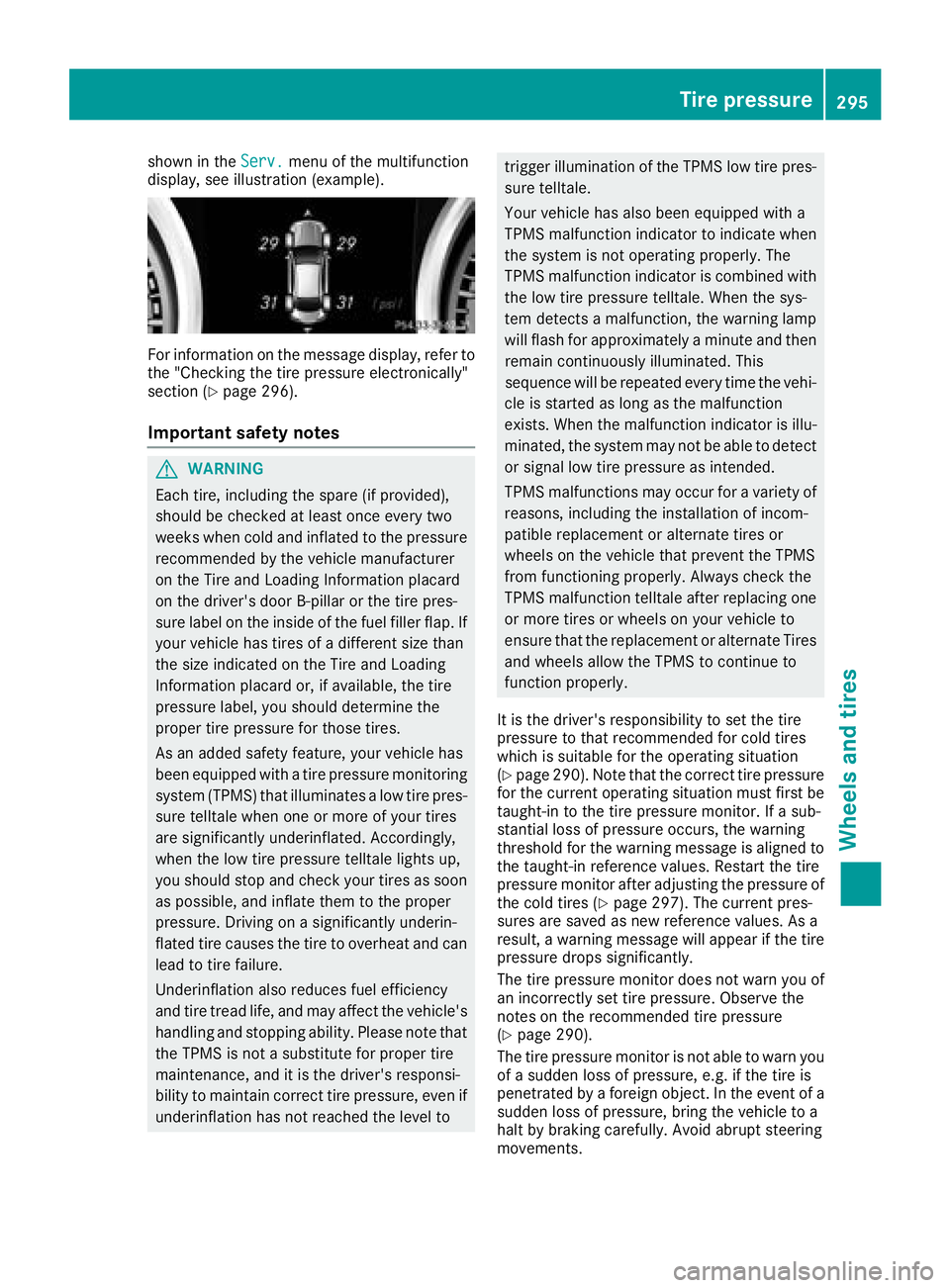
shown in the Serv. menu of the multifunction
display, see illustration (example).
For information on the message display, refer to
the "Checking the tire pressure electronically"
section ( Y
page 296).
Important safety notes
G WARNING
Each tire, including the spare (if provided),
should be checked at least once every two
weeks when cold and inflated to the pressure
recommended by the vehicle manufacturer
on the Tire and Loading Information placard
on the driver's door B-pillar or the tire pres-
sure label on the inside of the fuel filler flap. If
your vehicle has tires of ad ifferent size than
the size indicated on the Tire and Loading
Information placard or, if available, the tire
pressure label ,y ou should determine the
proper tire pressure for those tires.
As an added safety feature, your vehicle has
been equipped with at ire pressure monitoring
system (TPMS) that illuminates al ow tire pres-
sure telltale when one or more of your tires
are significantly underinflated. Accordingly,
when the low tire pressure telltale lights up,
you should stop and check your tires as soon
as possible ,a nd inflate them to the proper
pressure. Driving on as ignificantly underin-
flated tire causes the tire to overheat and can
lead to tire failure.
Underinflation also reduces fuel efficiency
and tire tread life, and may affect the vehicle's
handling and stopping ability. Please note that
the TPMS is not as ubstitute for proper tire
maintenance, and it is the driver's responsi-
bility to maintain correct tire pressure, even if
underinflation has not reached the level to trigger illumination of the TPMS low tire pres-
sure telltale.
Your vehicle has also been equipped with a
TPMS malfunction indicator to indicate when
the system is not operating properly. The
TPMS malfunction indicator is combined with
the low tire pressure telltale. When the sys-
tem detects am alfunction, the warning lamp
will flash for approximately am inute and then
remain continuously illuminated. This
sequence will be repeated every time the vehi-
cle is started as long as the malfunction
exists. When the malfunction indicator is illu-
minated, the system may not be able to detect
or signal low tire pressure as intended.
TPMS malfunctions may occur for av ariety of
reasons, including the installation of incom-
patible replacement or alternate tires or
wheels on the vehicle that prevent the TPMS
from functionin gp roperly. Always check the
TPMS malfunction telltale after replacing one
or more tires or wheels on your vehicle to
ensure that the replacement or alternate Tires
and wheels allow the TPMS to continue to
function properly.
It is the driver's responsibility to set the tire
pressure to that recommended for cold tires
which is suitable for the operating situation
( Y
page 290). Note that the correct tire pressure
for the current operating situation must first be
taught-in to the tire pressure monitor. If as ub-
stantial loss of pressure occurs, the warning
threshold for the warning message is aligned to
the taught-in reference values. Restart the tire
pressure monitor after adjusting the pressure of
the cold tires ( Y
page 297). The current pres-
sures are saved as new reference values. As a
result, aw arning message will appea rift he tire
pressure drops significantly.
The tire pressure monitor does not warn you of
an incorrectly set tire pressure. Observe the
notes on the recommended tire pressure
( Y
page 290).
The tire pressure monitor is not able to warn you
of as udden loss of pressure, e.g. if the tire is
penetrated by af oreign object. In the event of a
sudden loss of pressure, bring the vehicle to a
halt by braking carefully .A void abrupt steering
movements. Tire pressure 295
Wheels and tires Z